Numerical Investigation of Fracture Morphology Characteristics in Heterogeneous Reservoirs
Abstract
1. Introduction
2. Mathematical Model
2.1. Governing Equations in Porous Media
2.2. Phase Field Simulation for Fracture
2.3. The Continuity Equation for Flow Field
2.4. Initial Boundary Condition
3. Model Validation
4. Numerical Results and Discussion
4.1. Influence of Gravels on Fracture Deflection
4.2. Critical Bifurcating Injection Rate
4.3. Bifurcating due to Fluid Viscosity
4.4. Effects of Fracture Energy of Gravels and Interfaces
4.5. Effects of Rock Permeability
4.6. Influence of Content and Size of the Randomly Distributed Gravels
5. Conclusions
- (1)
- Hydraulic fracture is arrested by gravels as the Young’s modulus of the gravels is less than the rock matrix, and apart from the gravels if the Young’s modulus of the gravels is larger than rock matrix. The deflection of the hydraulic fracture is weakened as the distance between gravels and fracture increases.
- (2)
- The critical bifurcation injection rate is found to depend on the heterogeneity of the formation; the value of the critical bifurcation injection rate decreases with the decreasing of stress difference.
- (3)
- Weak interfaces between gravels and the rock matrix have a significant effect on the fracture propagation such as deflection and bifurcating.
- (4)
- Hydraulic fractures are more likely to bifurcate as the size of gravels is large enough.
Author Contributions
Funding
Institutional Review Board Statement
Informed Consent Statement
Data Availability Statement
Conflicts of Interest
References
- Gordeliy, E.; Abbas, S.; Peirce, A. Modeling nonplanar hydraulic fracture propagation using the XFEM: An implicit level-set algorithm and fracture tip asymptotics. Int. J. Solids Struct. 2019, 159, 135–155. [Google Scholar] [CrossRef]
- Rui, Z.; Peng, F.; Ling, K.; Chang, H.; Chen, G.; Zhou, X. Investigation into the performance of oil and gas projects. J. Nat. Gas. Sci. Eng. 2017, 38, 12–20. [Google Scholar] [CrossRef]
- Wang, D.; Zlotnik, S.; Diez, P.; Ge, H.; Zhou, F.; Yu, B. A Numerical Study on Hydraulic Fracturing Problems via the Proper Generalized Decomposition Method. Comput. Model Eng. Sci. 2020, 122, 703–720. [Google Scholar] [CrossRef]
- Zou, J.; Chen, W.; Yuan, J.; Yang, D.; Yang, J. 3-D numerical simulation of hydraulic fracturing in a CBM reservoir. J. Nat. Gas. Sci. Eng. 2017, 37, 386–396. [Google Scholar] [CrossRef]
- Ji, Y.; Wu, W.; Zhao, Z. Unloading-induced rock fracture activation and maximum seismic moment prediction. Eng. Geol. 2019, 262, 105352. [Google Scholar] [CrossRef]
- Yang, T.H.; Tham, L.G.; Tang, C.A.; Liang, Z.Z.; Tsui, Y. Influence of Heterogeneity of Mechanical Properties on Hydraulic Fracturing in Permeable Rocks. Rock Mech. Rock Eng. 2004, 37, 251–275. [Google Scholar] [CrossRef]
- Shi, F.; Wang, D.; Chen, X. A Numerical Study on the Propagation Mechanisms of Hydraulic Fractures in Fracture-Cavity Carbonate Reservoirs. Comput. Model Eng. Sci. 2021, 127, 575–598. [Google Scholar] [CrossRef]
- Zeng, Q.; Liu, W.; Yao, J. Effect of Vugs on Hydraulic Fracture Propagation with Phase Field Method. Lithosphere 2021, 2021, 4496747. [Google Scholar] [CrossRef]
- Li, M.; Tang, S.; Guo, T.; Qi, M. Numerical investigation of hydraulic fracture propagation in the glutenite reservoir. J. Geophys. Eng. 2018, 15, 2124–2138. [Google Scholar] [CrossRef]
- Lan, H.; Martin, C.D.; Hu, B. Effect of heterogeneity of brittle rock on micromechanical extensile behavior during compression loading. J. Geophys. Res. 2010, 115, B01202. [Google Scholar] [CrossRef]
- Zhang, Y.-Z.; Dusseault, M.B.; Yassir, N.A. Effects of rock anisotropy and heterogeneity on stress distributions at selected sites in North America. Eng. Geol. 1994, 37, 181–197. [Google Scholar] [CrossRef]
- Wu, M.; Wang, W.; Song, Z.; Liu, B.; Feng, C. Exploring the influence of heterogeneity on hydraulic fracturing based on the combined finite–discrete method. Eng. Fract. Mech. 2021, 252, 107835. [Google Scholar] [CrossRef]
- Jeffrey, R.G.; Bunger, A.P.; Lecampion, B. Measuring Hydraulic Fracture Growth in Naturally Fractured Rock. In All Days; SPE: New Orleans, LA, USA, 2009; SPE-124919-MS. [Google Scholar]
- Nasehi, M.J.; Mortazavi, A. Effects of in-situ stress regime and intact rock strength parameters on the hydraulic fracturing. J. Pet. Sci. Eng. 2013, 108, 211–221. [Google Scholar] [CrossRef]
- Yan, C.; Zheng, H. FDEM-flow3D: A 3D hydro-mechanical coupled model considering the pore seepage of rock matrix for simulating three-dimensional hydraulic fracturing. Comput. Geotech. 2017, 81, 212–228. [Google Scholar] [CrossRef]
- Yi, L.P.; Waisman, H.; Yang, Z.Z.; Li, X.G. A consistent phase field model for hydraulic fracture propagation in poroelastic media. Comput. Methods Appl. Mech. Eng. 2020, 372, 113396. [Google Scholar] [CrossRef]
- Yoshioka, K.; Mollaali, M.; Kolditz, O. Variational phase-field fracture modeling with interfaces. Comput. Methods Appl. Mech. Eng. 2021, 384, 113951. [Google Scholar] [CrossRef]
- Xia, L.; Yvonnet, J.; Ghabezloo, S. Phase field modeling of hydraulic fracturing with interfacial damage in highly heterogeneous fluid-saturated porous media. Eng. Fract. Mech. 2017, 186, 158–180. [Google Scholar] [CrossRef]
- Ju, Y.; Liu, P.; Chen, J.; Yang, Y.; Ranjith, P.G. CDEM-based analysis of the 3D initiation and propagation of hydrofracturing cracks in heterogeneous glutenites. J. Nat. Gas. Sci. Eng. 2016, 35, 614–623. [Google Scholar] [CrossRef]
- Sarmadivaleh, M.; Rasouli, V. Test Design and Sample Preparation Procedure for Experimental Investigation of Hydraulic Fracturing Interaction Modes. Rock. Mech. Rock. Eng. 2015, 48, 93–105. [Google Scholar] [CrossRef]
- Guo, J.; Lu, Q.; Chen, H.; Wang, Z.; Tang, X.; Chen, L. Quantitative phase field modeling of hydraulic fracture branching in heterogeneous formation under anisotropic in-situ stress. J. Nat. Gas. Sci. Eng. 2018, 56, 455–471. [Google Scholar] [CrossRef]
- Zou, J.; Jiao, Y.Y.; Tang, Z.; Ji, Y.; Yan, C.; Wang, J. Effect of mechanical heterogeneity on hydraulic fracture propagation in unconventional gas reservoirs. Comput. Geotech. 2020, 125, 103652. [Google Scholar] [CrossRef]
- Rui, Z.; Guo, T.; Feng, Q.; Qu, Z.; Qi, N.; Gong, F. Influence of gravel on the propagation pattern of hydraulic fracture in the glutenite reservoir. J. Pet. Sci. Eng. 2018, 165, 627–639. [Google Scholar] [CrossRef]
- Zhou, J.; Huang, H.; Deo, M. Simulation of Hydraulic and Natural Fracture Interaction Using a Coupled DFN-DEM Model. In 50th US Rock Mechanics/Geomechanics Symposium; OnePetro: online, 2016. [Google Scholar]
- Chang, X.; Guo, Y.; Zhou, J.; Song, X.; Yang, C. Numerical and Experimental Investigations of the Interactions between Hydraulic and Natural Fractures in Shale Formations. Energies 2018, 11, 2541. [Google Scholar] [CrossRef]
- Zhang, Y.; Liu, Z.; Han, B.; Zhu, S.; Zhang, X. Numerical study of hydraulic fracture propagation in inherently laminated rocks accounting for bedding plane properties. J. Pet. Sci. Eng. 2022, 210, 109798. [Google Scholar] [CrossRef]
- Wang, D.; Shi, F.; Qin, H.; Sun, D.; Yu, B. Failure Patterns and Mechanisms of Hydraulic Fracture Propagation Behavior in the Presence of Naturally Cemented Fractures. Comput. Model Eng. Sci. 2021, 126, 891–914. [Google Scholar] [CrossRef]
- Wan, L.; Chen, M.; Hou, B.; Kao, J.; Zhang, K.; Fu, W. Experimental investigation of the effect of natural fracture size on hydraulic fracture propagation in 3D. J. Struct. Geol. 2018, 116, 1–11. [Google Scholar] [CrossRef]
- Tiedeman, C.R.; Barrash, W. Hydraulic Tomography: 3D Hydraulic Conductivity, Fracture Network, and Connectivity in Mudstone. Groundwater 2020, 58, 238–257. [Google Scholar] [CrossRef]
- Zhao, X.; Rui, Z.; Liao, X.; Zhang, R. The qualitative and quantitative fracture evaluation methodology in shale gas reservoir. J. Nat. Gas. Sci. Eng. 2015, 27, 486–495. [Google Scholar] [CrossRef]
- Yu, H.; Xu, H.; Fan, J.; Zhu, Y.B.; Wang, F.; Wu, H. Transport of Shale Gas in Microporous/Nanoporous Media: Molecular to Pore-Scale Simulations. Energy Fuels. 2021, 35, 911–943. [Google Scholar] [CrossRef]
- Xu, W.; Yu, H.; Zhang, J. Phase-field method of crack branching during SC-CO2 fracturing: A new energy release rate criterion coupling pore pressure gradient. Comput. Methods Appl. Mech. Eng. 2022, 399, 115366. [Google Scholar] [CrossRef]
- Taheri-Shakib, J.; Ghaderi, A.; Hosseini, S.; Hashemi, A. Debonding and coalescence in the interaction between hydraulic and natural fracture: Accounting for the effect of leak-off. J. Nat. Gas. Sci. Eng. 2016, 36, 454–462. [Google Scholar] [CrossRef]
- Zi, G.; Belytschko, T. New crack-tip elements for XFEM and applications to cohesive cracks. Int. J. Numer. Methods Eng. 2003, 57, 2221–2240. [Google Scholar] [CrossRef]
- Kim, J.; Moridis, G.J. Numerical analysis of fracture propagation during hydraulic fracturing operations in shale gas systems. Int. J. Rock. Mech. Min. Sci. 2015, 76, 127–137. [Google Scholar] [CrossRef]
- Yushi, Z.; Xinfang, M.; Shicheng, Z.; Tong, Z.; Han, L. Numerical Investigation into the Influence of Bedding Plane on Hydraulic Fracture Network Propagation in Shale Formations. Rock. Mech. Rock. Eng. 2016, 49, 3597–3614. [Google Scholar] [CrossRef]
- Liu, L.; Li, L.; Elsworth, D.; Zhi, S.; Yu, Y. The Impact of Oriented Perforations on Fracture Propagation and Complexity in Hydraulic Fracturing. Processes 2018, 6, 213. [Google Scholar] [CrossRef]
- Shi, S.; Zhuo, R.; Cheng, L.; Xiang, Y.; Ma, X.; Wang, T. Fracture Characteristics and Distribution in Slant Core from Conglomerate Hydraulic Fracturing Test Site (CHFTS) in Junggar Basin, Northwest China. Processes 2022, 10, 1646. [Google Scholar] [CrossRef]
- Li, Z.; Li, L.; Zhang, Z.; Li, M.; Zhang, L.; Huang, B.; Tang, C. The Fracturing Behavior of Tight Glutenites Subjected to Hydraulic Pressure. Processes 2018, 6, 96. [Google Scholar] [CrossRef]
- Tang, J.; Liu, B.; Zhang, G. Investigation on the Propagation Mechanisms of a Hydraulic Fracture in Glutenite Reservoirs Using DEM. Energies 2022, 15, 7709. [Google Scholar] [CrossRef]
- Chen, Z. Finite element modelling of viscosity-dominated hydraulic fractures. J. Pet. Sci. Eng. 2012, 88–89, 136–144. [Google Scholar] [CrossRef]
- Ren, Q.; Dong, Y.; Yu, T. Numerical modeling of concrete hydraulic fracturing with extended finite element method. Sci. China Ser. E Technol. Sci. 2009, 52, 559–565. [Google Scholar] [CrossRef]
- Dong, C.Y.; de Pater, C.J. Numerical implementation of displacement discontinuity method and its application in hydraulic fracturing. Comput. Methods Appl. Mech. Eng. 2001, 191, 745–760. [Google Scholar] [CrossRef]
- Ni, L.; Zhang, X.; Zou, L.; Huang, J. Phase-field modeling of hydraulic fracture network propagation in poroelastic rocks. Comput. Geosci. 2020, 24, 1767–1782. [Google Scholar] [CrossRef]
- Zhou, S.; Zhuang, X.; Rabczuk, T. Phase-field modeling of fluid-driven dynamic cracking in porous media. Comput. Methods Appl. Mech. Eng. 2019, 350, 169–198. [Google Scholar] [CrossRef]
- Zou, J.; Jiao, Y.Y.; Tan, F.; Lv, J.; Zhang, Q. Complex hydraulic-fracture-network propagation in a naturally fractured reservoir. Comput. Geotech. 2021, 135, 104165. [Google Scholar] [CrossRef]
- Santillán, D.; Juanes, R.; Cueto-Felgueroso, L. Phase field model of fluid-driven fracture in elastic media: Immersed-fracture formulation and validation with analytical solutions. J. Geophys. Res. Solid. Earth. 2017, 122, 2565–2589. [Google Scholar] [CrossRef]
- Biot, M.A. Theory of Elasticity and Consolidation for a Porous Anisotropic Solid. J. Appl. Phys. 1955, 26, 182–185. [Google Scholar] [CrossRef]
- Biot, M.A. General Theory of Three-Dimensional Consolidation. J. Appl. Phys. 1941, 12, 155–164. [Google Scholar] [CrossRef]
- Zhou, S.; Ma, J. Phase field characteristic of multizone hydraulic fracturing in porous media: The effect of stress boundary. Eur. J. Environ. Civ. Eng. 2022, 26, 3043–3063. [Google Scholar] [CrossRef]
- Miehe, C.; Hofacker, M.; Welschinger, F. A phase field model for rate-independent crack propagation: Robust algorithmic implementation based on operator splits. Comput. Methods Appl. Mech. Eng. 2010, 199, 2765–2778. [Google Scholar] [CrossRef]
- Lee, S.; Wheeler, M.F.; Wick, T. Pressure and fluid-driven fracture propagation in porous media using an adaptive finite element phase field model. Comput. Methods Appl. Mech. Eng. 2016, 305, 111–132. [Google Scholar] [CrossRef]
- Zhou, S.; Rabczuk, T.; Zhuang, X. Phase field modeling of quasi-static and dynamic crack propagation: COMSOL implementation and case studies. Adv. Eng. Softw. 2018, 122, 31–49. [Google Scholar] [CrossRef]
- Zhou, S.; Zhuang, X.; Rabczuk, T. A phase-field modeling approach of fracture propagation in poroelastic media. Eng. Geol. 2018, 240, 189–203. [Google Scholar] [CrossRef]
- Borden, M.J.; Verhoosel, C.V.; Scott, M.A.; Hughes, T.J.R.; Landis, C.M. A phase-field description of dynamic brittle fracture. Comput. Methods Appl. Mech. Eng. 2012, 217–220, 77–95. [Google Scholar] [CrossRef]
- Escobar, R.G.; Sanchez, E.C.M.; Roehl, D.; Romanel, C. Xfem modeling of stress shadowing in multiple hydraulic fractures in multi-layered formations. J. Nat. Gas. Sci. Eng. 2019, 70, 102950. [Google Scholar] [CrossRef]
- Luo, Z.; Xie, Y.; Zhao, L.; Cheng, L.; Wen, G.; Wang, C.; Gao, Y.; Wang, N. A Random-XFEM technique modeling of hydraulic fracture interaction with natural void. Energy Sci. Eng. 2022, 10, 2637–2660. [Google Scholar] [CrossRef]
- Fan, H.; Li, S.; Feng, X.T.; Zhu, X. A high-efficiency 3D boundary element method for estimating the stress/displacement field induced by complex fracture networks. J. Pet. Sci. Eng. 2020, 187, 106815. [Google Scholar] [CrossRef]
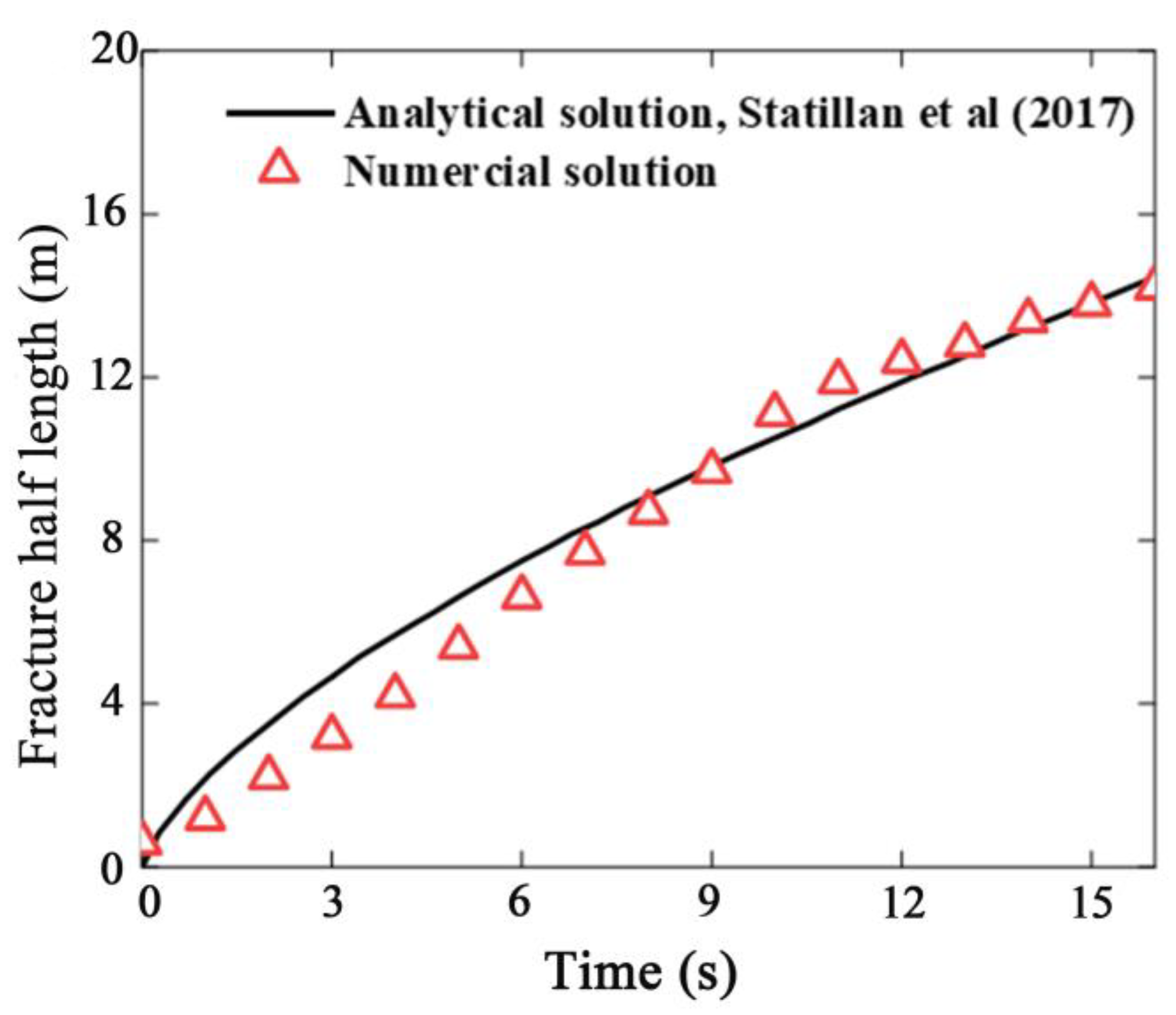
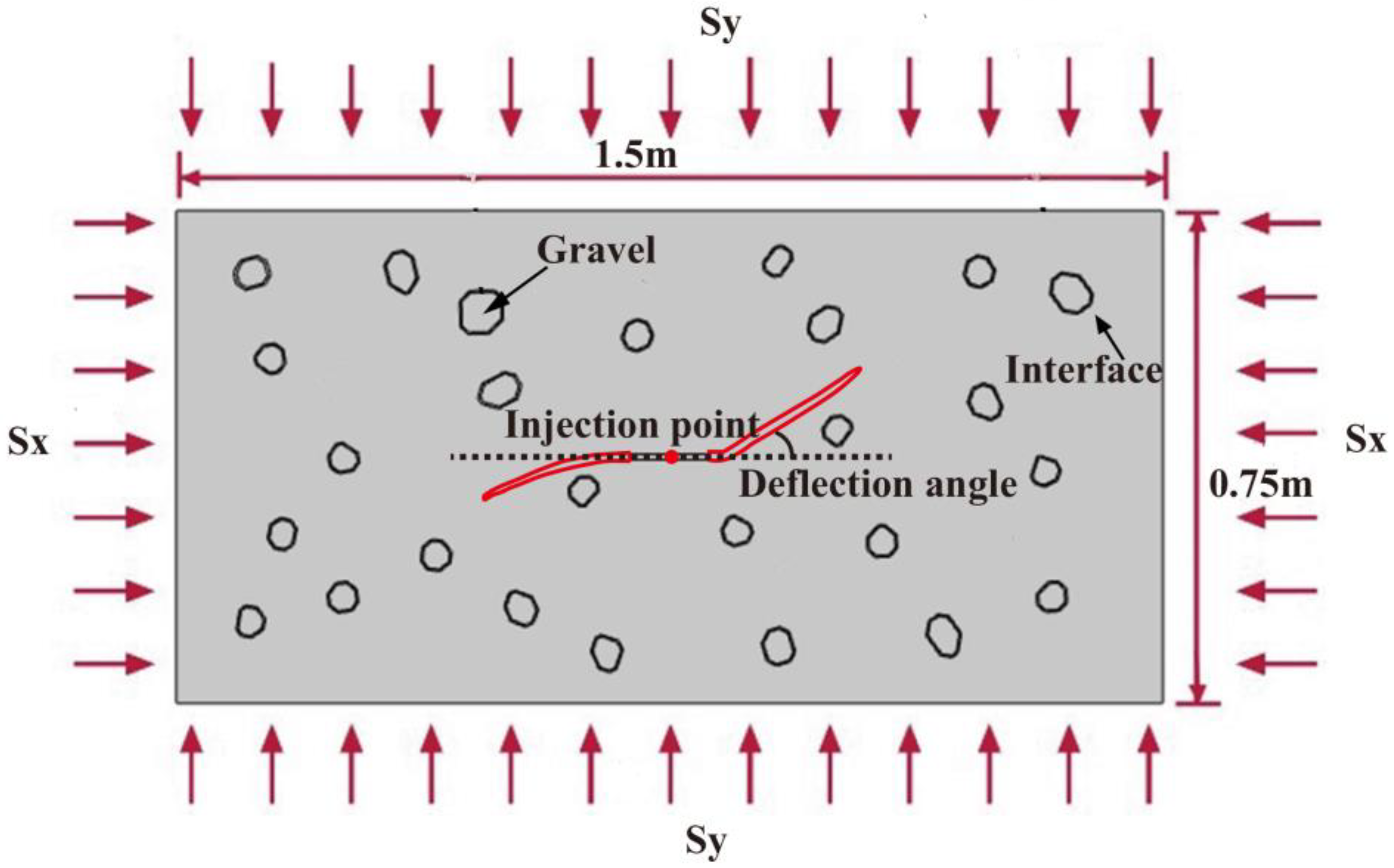


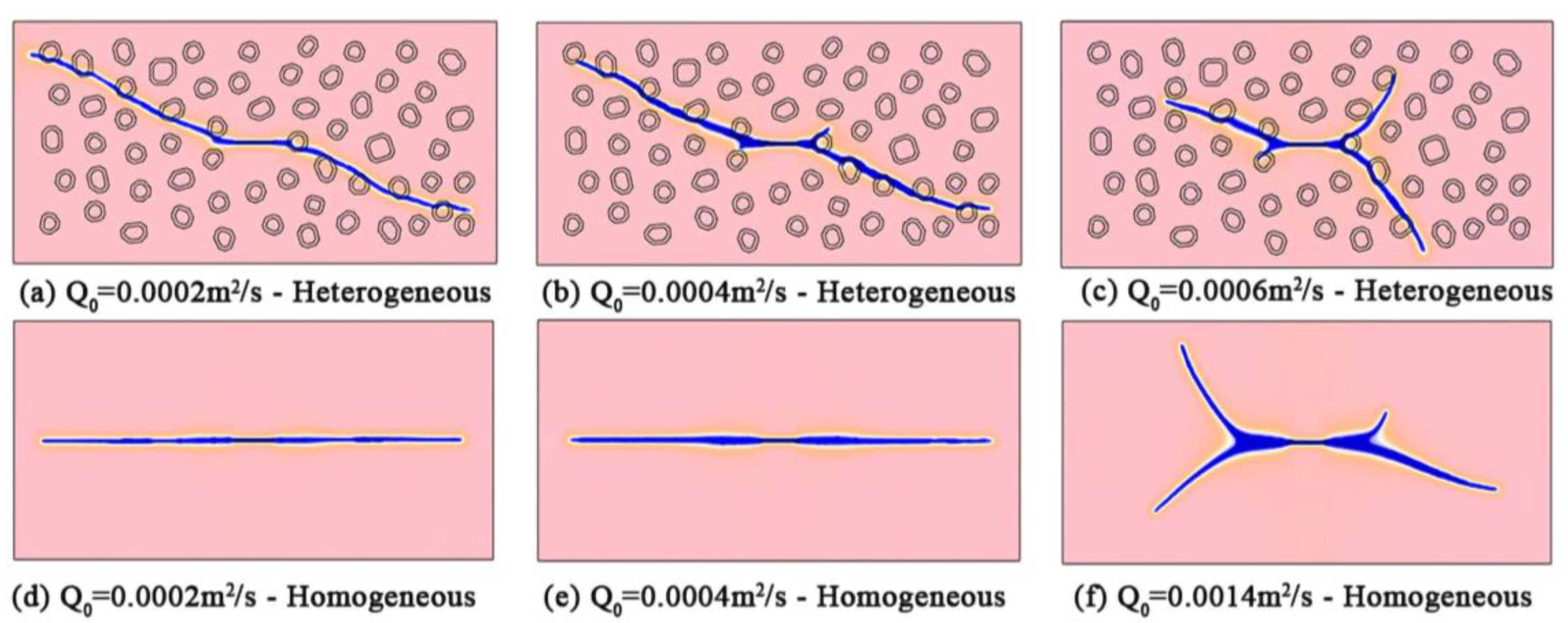

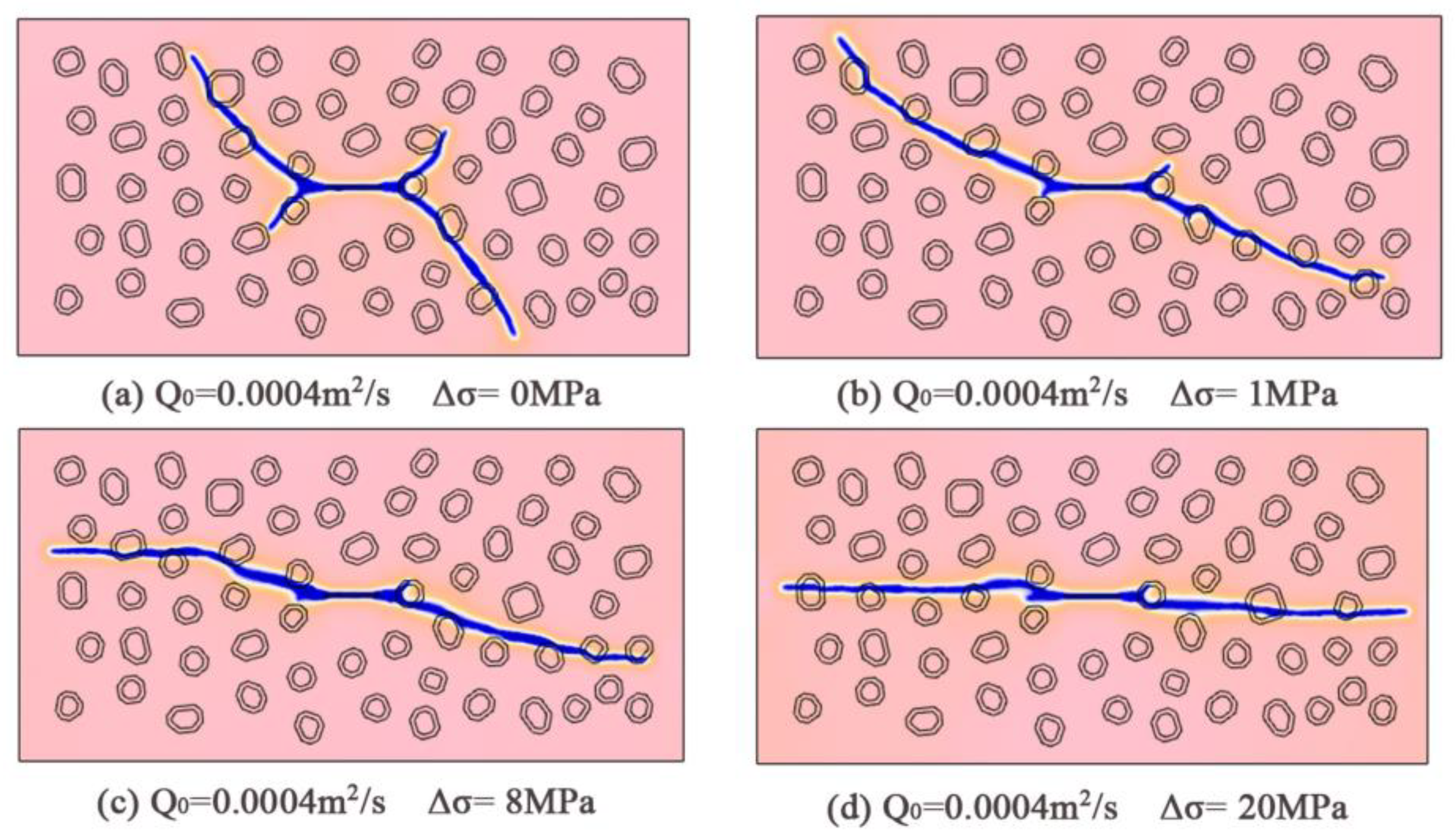
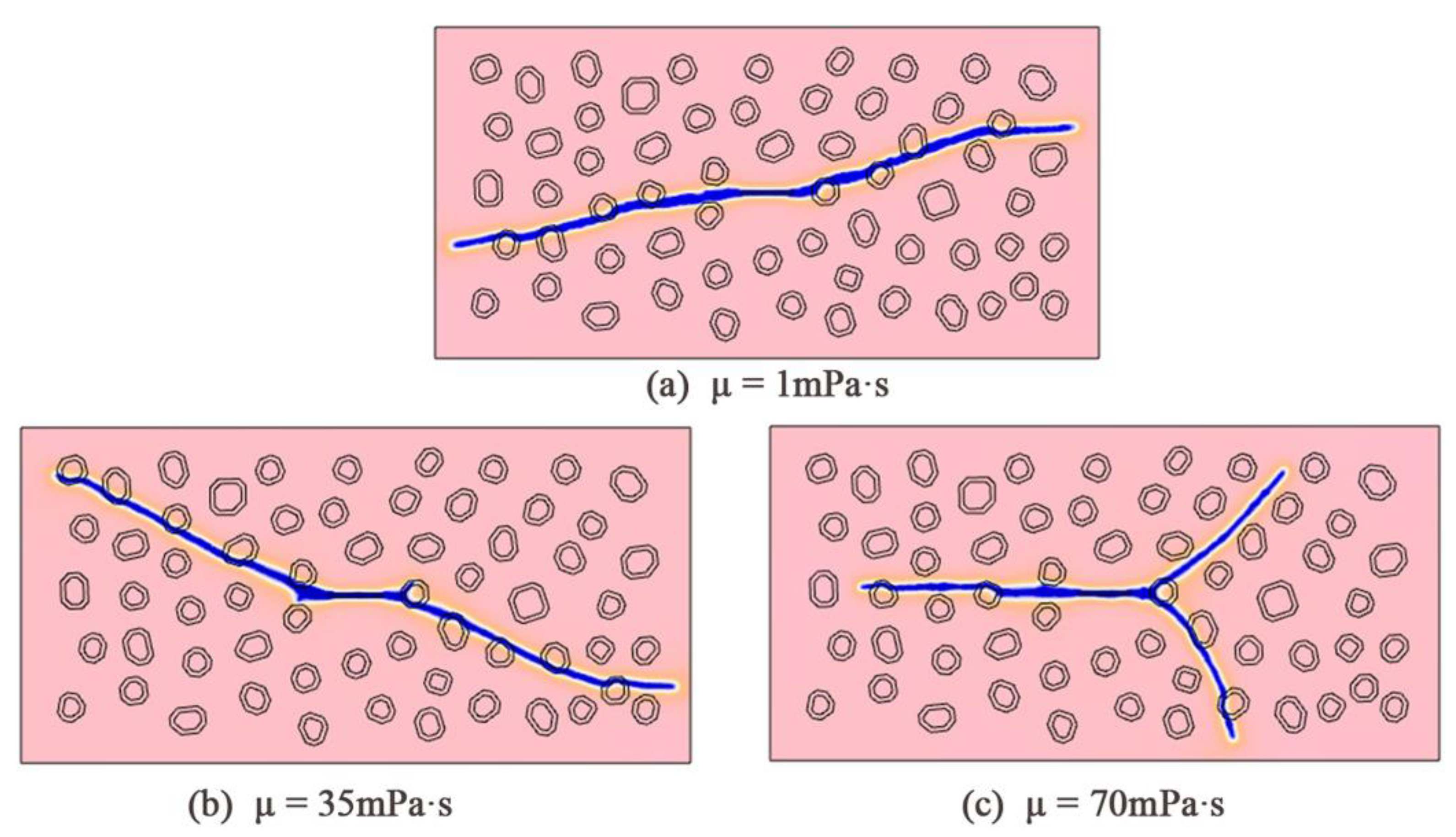

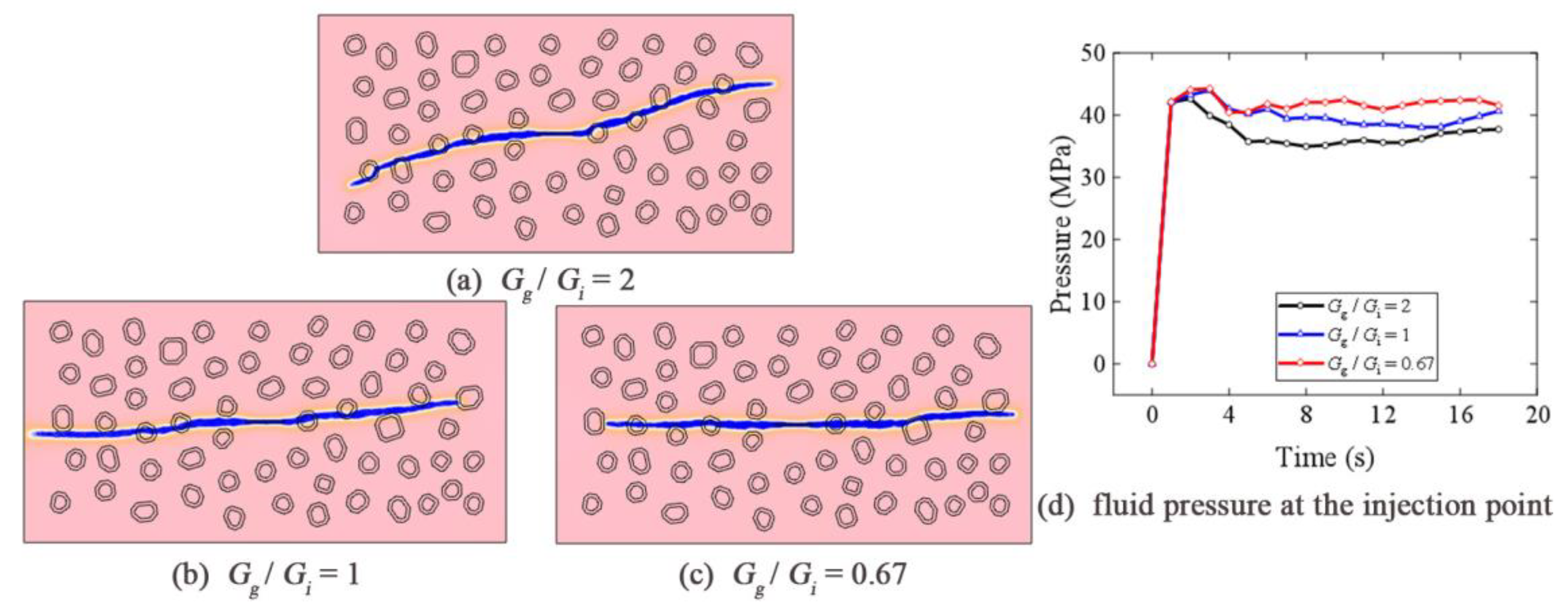
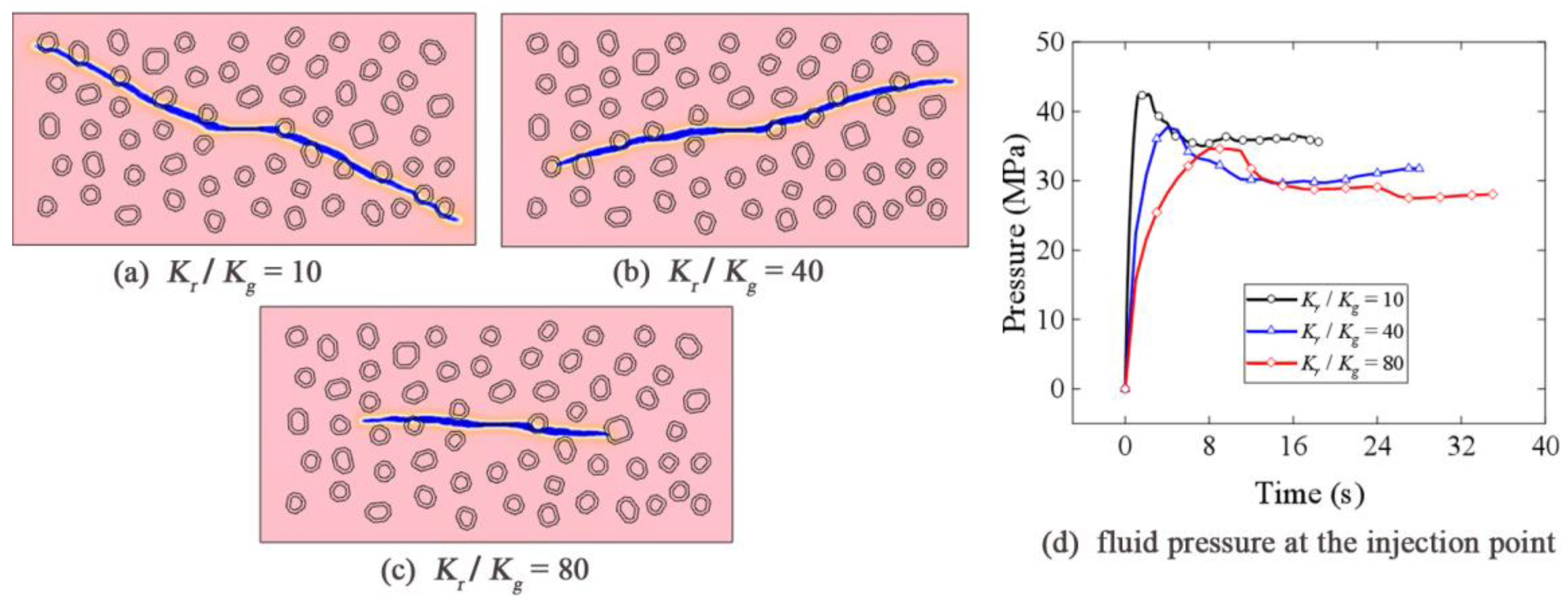

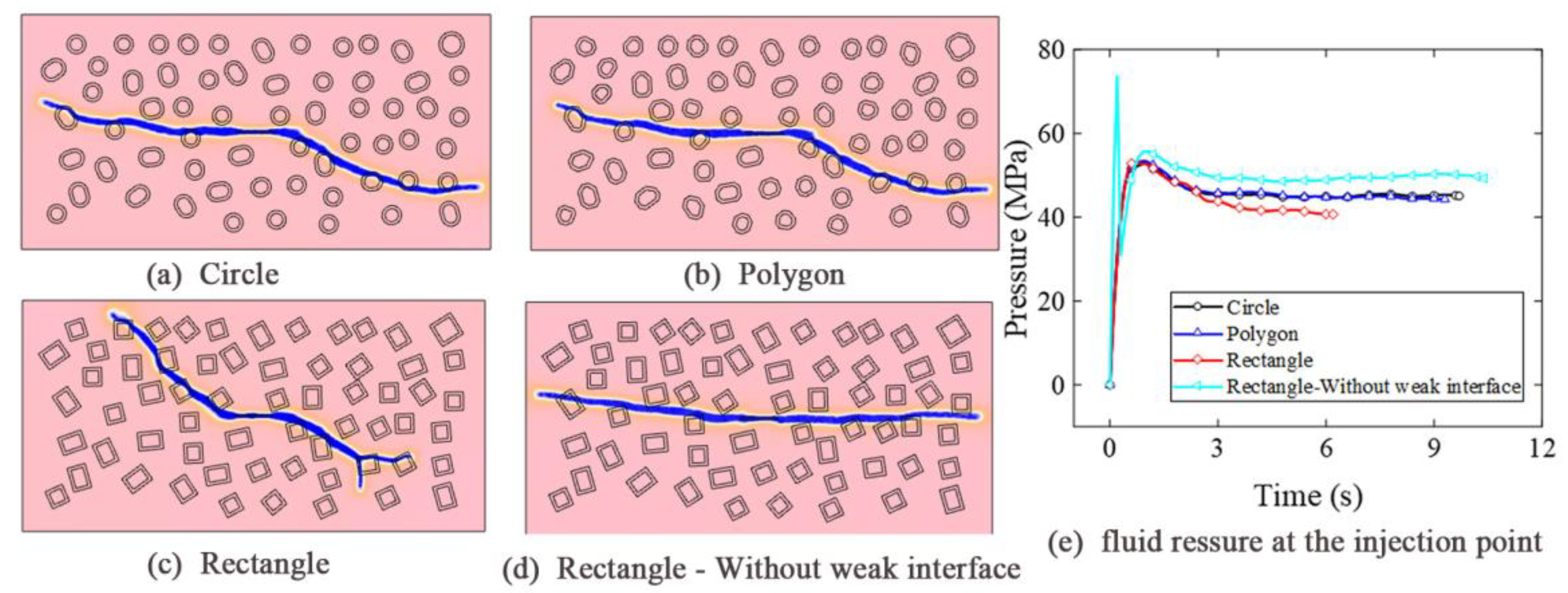

| 4.722 GPa | 7.083 GPa | 0.4 | 1.0 | ||||
| 120 N/m | 1 × 10−9 | 0.28 m | 0.06 | ||||
| 1.0 × 103 kg/m3 | 1.0 × 103 kg/m3 | 0.06 | 1.0 × 10−3 Pa·s | ||||
| 1.0 × 10−6 Pa·s | 105 | 2 | 1 × 10−8 1/Pa |
| 30 GPa | 0.25 | 0.4 | 1.0 | ||||
| 1 × 105 | 2 | 1.0 × 103 kg/m3 | 1.0 × 103 kg/m3 | ||||
| 1.0 × 10−3 Pa·s | 1.0 × 10−3 Pa·s | 3000 N/m | 0.2 × 10−15 m2 | ||||
| 0.05 | 1 × 10−8 1/Pa | 0.05 | 0.008 m |
| Gravel | Interface | ||
|---|---|---|---|
| 40 GPa | 15 GPa | ||
| 4000 N/m | 2000 N/m | ||
| 0.1 × 10−15 m2 | 0.1 × 10−15 m2 | ||
Publisher’s Note: MDPI stays neutral with regard to jurisdictional claims in published maps and institutional affiliations. |
© 2022 by the authors. Licensee MDPI, Basel, Switzerland. This article is an open access article distributed under the terms and conditions of the Creative Commons Attribution (CC BY) license (https://creativecommons.org/licenses/by/4.0/).
Share and Cite
Cao, Y.; He, Q.; Liu, C. Numerical Investigation of Fracture Morphology Characteristics in Heterogeneous Reservoirs. Processes 2022, 10, 2604. https://doi.org/10.3390/pr10122604
Cao Y, He Q, Liu C. Numerical Investigation of Fracture Morphology Characteristics in Heterogeneous Reservoirs. Processes. 2022; 10(12):2604. https://doi.org/10.3390/pr10122604
Chicago/Turabian StyleCao, Yuling, Qiangsheng He, and Chuang Liu. 2022. "Numerical Investigation of Fracture Morphology Characteristics in Heterogeneous Reservoirs" Processes 10, no. 12: 2604. https://doi.org/10.3390/pr10122604
APA StyleCao, Y., He, Q., & Liu, C. (2022). Numerical Investigation of Fracture Morphology Characteristics in Heterogeneous Reservoirs. Processes, 10(12), 2604. https://doi.org/10.3390/pr10122604






